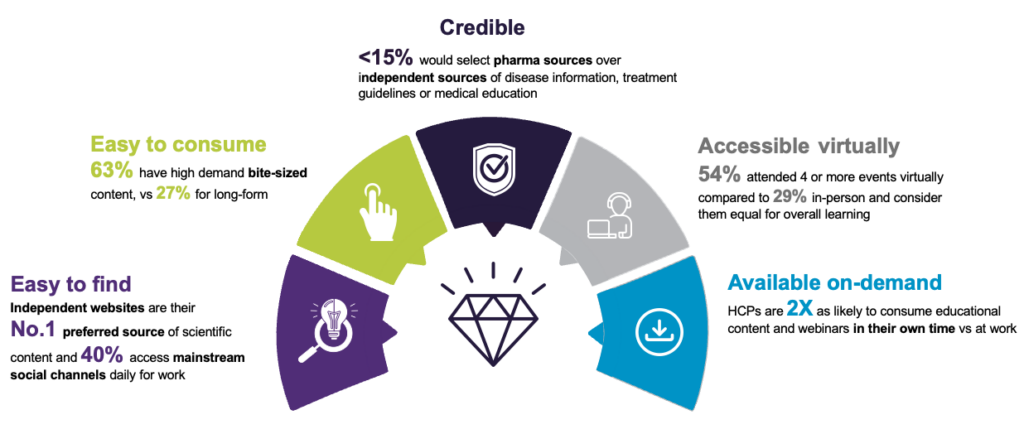Published 17 November 2023
Webinar roundup: Unlocking meaningful impact metrics for medical affairs
Breaking down internal silos to establish more integrated, cross-functional teams with a unified understanding of HCP needs and behaviour would help pharmaceutical companies boost the measurable impact of their HCP engagement activity.
This was among the key points of consensus from a recent forum of industry leaders – hosted by Impatient Health and supported by EPG Health – which discussed the way forward for measuring impact in medical affairs.

Exploring findings from EPG Health’s latest research report, the Mighty Medical webinar chaired by Impatient Chief Executive Paul Simms heard that HCP insight (needs and behaviour) is the number 1 strategic priority for medical departments in 2024.
Although the research finds that 75% of pharma consider the overall effectiveness of their HCP engagement to be at least ‘satisfactory’, basic volume or “vanity” metrics have often been relied upon to demonstrate impact in years gone by. Meanwhile:
- 63% of those in medical functions find demonstrating behavioural impact / outcomes a major challenge
- <20% measure knowledge gain, behaviour change or impact in practice for most of their HCP engagement activities
- 68% think their organisation’s digital maturity is ‘adolescent’ at best
- Just 1 in 4 comprehensively share or act upon data insights
SENIOR LEADERS SHARE PERSPECTIVES
![]()
“We don’t have to rely on the ‘bums on seats’ level of delivery anymore, we need insights to create strategy. That strategy creates the ’why’ for which we then take clear, deliberate action using all the tools we have in medical affairs, to deliver impact. We know what we are measuring because it is answering that question of our strategic ‘why’.
“Using an outside-in business model where you are applying value into a system, you can define what value looks like together (as a whole organisation). Then you decide as a team the prioritisation or resource allocation to make an impact on that system.”
Heather Moses, Head of Europe & Canada Medical Affairs, AstraZeneca
![]()
“I think the challenge we have faced is that we have always gone with these volume metrics to justify our existence, it was a measure we could attach ourselves on. But as we move in this digital space, it’s a very artificial measure of impact.
“We should break down what we are trying to achieve. What are the steps we are incrementally going to be able to take in order to achieve our overall ambition, and what might be those surrogate markers?”
Emma Booth, Director, Global Medical Digital Strategy, Amgen
![]()
“Whether you are delivering medical content or promotional content, different functions of pharma share the same customer. But do we in pharma really look to break down the silos that we have created for ourselves, between commercial and medical for example, to try and share insights across each other?
“If we are truly going to deliver content that is impactful – content that delivers value to the customer and drives a strong level of engagement – we must first foundationally understand why that customer does what they do in the first place. Thinking about these silos is a key piece in that. Having more integrated, cross-functional team ownership of an asset or therapeutic area is, I think, the model of the future.”
Arvashni Seeripat, SVP Head of Global Innovative Medicine, Grünenthal Group
![]()
“Whether it is from the medical function or a commercial function, (we need) an internal enterprise mindset of being able to talk to each other to different departments, breaking down the silos and being able to measure and drive impact (for the benefit of patients). At the end of the day patients can’t wait, and that’s what we are here to do.”
Tomasz Piotrowski, Head, Medical Affairs Innovation Lab, Novartis
For further insight from the panellists, whose views are their own and do not necessarily represent those of their organisations, watch the full webinar recording
DELIVERING VALUE AND MEASURING IMPACT
EPG Health’s Chief Operating Officer Jonathan Macdonald and Head of Scientific Services Ben Gallarda discussed key findings from the research report and told the session that “unless we are delivering value for the healthcare professionals, then we are not going to see the impact”.

Content type, format, source and channel are all important factors in meeting the needs of time-poor, digitally savvy healthcare professionals; they demand content that is:

“You have got to have a multimodal approach in order to support the different learning styles.”
Jonathan Macdonald went on to discuss EPG Health’s approach to meaningfully determining the impact of educational programmes on Medthority (www.medthority.com), an independent website for healthcare professionals worldwide. This digital Impact Outcomes Framework provides a structured methodology to assess the fulfilment of identified educational needs.
To determine impact, he explained, core engagement metrics and ‘impact outcome’ metrics need to be considered in combination. This includes asking healthcare professionals if they have experienced knowledge gain, and if they feel more competent post-engagement.
“When you put those metrics together, you can start to identify whether you have addressed the educational need. But the most important bit is what do we then do with that?
“Armed with these insights, you can start to consider the personal requirement of the healthcare professional, identifying the content that is most relevant to address their educational need. If we are providing them relevant, up-to-date content, they will engage, they will see value and they will learn.”
CAN WE HELP YOU DELIVER MEASURABLE HCP ENGAGEMENT IMPACT?
Learn more about Medthority or, to discuss your needs, book a meeting.
News & Views
MORE ARTICLES